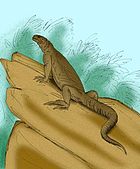| Palaeosaniwa Temporal range: Late Cretaceous 70.6–66.0 Ma PreꞒ Ꞓ O S D C P T J K Pg N ↓ Possible Paleocene record | |
|---|---|

| |
| Scientific classification | |
| Domain: | Eukaryota |
| Kingdom: | Animalia |
| Phylum: | Chordata |
| Class: | Reptilia |
| Order: | Squamata |
| Suborder: | Anguimorpha |
| Genus: | †Palaeosaniwa |
| Species: | †P. canadensis |
| Binomial name | |
| †Palaeosaniwa canadensis Gilmore, 1928 | |
| Synonyms | |
| |
Palaeosaniwa canadensis is an extinct species of carnivorous lizard from the late Cretaceous of North America. The name, given by Charles Whitney Gilmore in 1928, means "ancient Saniwa from Canada".
Description
Palaeosaniwa is among the largest terrestrial lizards known from the Mesozoic era, with an estimated body mass of 6 kg (13 lb) and a snout–vent length about 82 cm (32 in). Its total body length would have been around 1–2 m (3 ft 3 in – 6 ft 7 in), smaller than the adult Komodo dragon and other Mesozoic lizards of East Asia (Asprosaurus and Chianghsia). Some specimens attributed to cf. P. canadensis is estimated to have skull length up to 15 centimetres (5.9 in) which is comparable to a young specimen of komodo dragon around 1.6 m (5.2 ft) long. It is similar to modern varanid lizards (particularly the Komodo dragon) in having bladelike teeth with minute serrations. These teeth would have been effective for seizing and cutting large prey items, and suggest that Palaeosaniwa fed on other vertebrates. Adult Palaeosaniwa would have been large enough to prey on any of the avialans or mammals known from the time, small non-avian dinosaurs, and the eggs and juveniles of large dinosaurs.
Distribution
Palaeosaniwa was originally described from the late Campanian of Alberta. More recently it has been reported from the late Campanian of Montana, and the late Maastrichtian of Montana and Wyoming. It is known primarily from isolated teeth and vertebrae, but two partial skeletons have also been discovered. The type species, P. canadensis, is from Alberta. Although the Maastrichtian Palaeosaniwa has traditionally been referred to this species, it succeeds it by roughly ten million years. Given the distance in time between these animals, they are likely to represent distinct species, but the available fossils are too incomplete to be certain.
Relationships
Palaeosaniwa is a member of the Platynota, a group that includes the monitor lizards (Varanidae) and Gila monsters (Helodermatidae). Originally, it was thought to be a member of the Varanidae, but has also been interpreted as a relative of the Helodermatidae. The most recent analysis places Palaeosaniwa outside of either Varanidae or Helodermatidae, as a stem member of the Varanoidea. Its precise affinities remain poorly understood, but it may be related to other Late Cretaceous, North American carnivorous lizards such as Parasaniwa, Paraderma, Labrodioctes, and Cemeterius.
References
- ^ "Palaeosaniwa canadensis". Paleobiology Database. Retrieved 2 May 2021.
- Fox, Richard C (1984). "First North American Record of the Paleocene Primate Saxonella". Journal of Paleontology. 58 (3): 892–894. JSTOR 1304925.
- Longrich, Nicholas R.; Bhullar, Bhart-Anjan S.; Gauthier, Jacques A. (26 December 2012). "Mass extinction of lizards and snakes at the Cretaceous–Paleogene boundary". Proceedings of the National Academy of Sciences. 109 (52): 21396–21401. Bibcode:2012PNAS..10921396L. doi:10.1073/pnas.1211526110. ISSN 0027-8424. PMC 3535637. PMID 23236177. Supplementary Information
- Longrich, Nicholas R.; Horner, John R.; Erickson, Gregory M.; Currie, Philip J. (2010). "Cannibalism in Tyrannosaurus rex". PLOS ONE. 5 (10): e13419. Bibcode:2010PLoSO...513419L. doi:10.1371/journal.pone.0013419. ISSN 1932-6203. PMC 2955550. PMID 20976177.
- Cabezuelo Hernández, A.; Bolet, A.; Torices, A.; Pérez-García, A. (1 March 2022). "Identification of a large anguimorph lizard (Reptilia, Squamata) by an articulated hindlimb from the upper Maastrichtian (Upper Cretaceous) of Basturs-1 (Lleida, Spain)". Cretaceous Research. 131: 105094. Bibcode:2022CrRes.13105094C. doi:10.1016/j.cretres.2021.105094. ISSN 0195-6671. S2CID 244352137.
- Park, Jin-Young; Evans, Susan E.; Huh, Min (2015). "The first lizard fossil (Reptilia: Squamata) from the Mesozoic of South Korea" (PDF). Cretaceous Research. 55: 292–302. Bibcode:2015CrRes..55..292P. doi:10.1016/j.cretres.2015.03.001.
- Hamilton, Samantha M.; Paparella, Ilaria; Bell, Phil R.; Campione, Nicolás E.; Fanti, Federico; Larson, Derek W.; Sissons, Robin L.; Vavrek, Matthew J.; Balsai, Michael J.; Sullivan, Corwin (2023). "New Lizard Specimens from the Campanian Wapiti Formation of Alberta, Canada". Geosciences. 13 (11): 337. Bibcode:2023Geosc..13..337H. doi:10.3390/geosciences13110337. hdl:11585/954542. ISSN 2076-3263.
- Michael Joseph Balsai, The phylogenetic position of Palaeosaniwa and the early evolution of the Platynotan (Varanoid) anguimorphs (January 1, 2001). Univ. of Pennsylvania – Electronic Dissertations. Paper AAI3031637]
| Taxon identifiers | |
|---|---|
| Palaeosaniwa | |
| Palaeosaniwa canadensis | |




